What's Your Geology IQ?
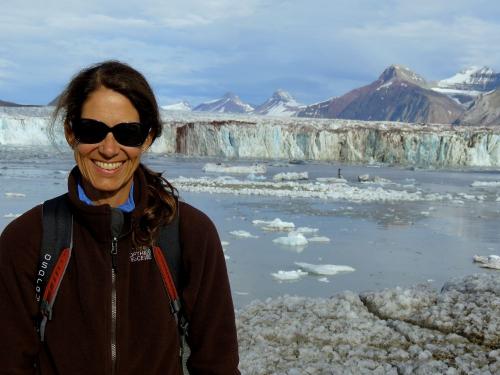 My Rocks Are Gneiss, Don’t Take Them For Granite!
My Rocks Are Gneiss, Don’t Take Them For Granite!
We were out in the boats today to test the instruments and collect data. The winds have not been in our favor. The wind is blowing toward the glacier which keeps all the bergs right next to the ice front. This makes it hard for us to get close to the glacier and difficult to deploy our instruments because there is just so much ice in the water. But I noticed this evening that the wind is shifting....
After a few test runs with the CTD, we decided to beach the boats, hoof it and check out the glacier from above. What a fascinating world! We were walking over landscape that is brand new- just a few years ago it was part of the glacier. Signs of glaciated landscape were everywhere.
So with that, I present, "Test Your Geology IQ". See how many questions you can answer about what we saw today. (Come on, it's easy!) Answers and scoring are at the end. Write how you did in the comments section!
- Why is this rock all scratched up? (Hint- think of what it has just been through!)
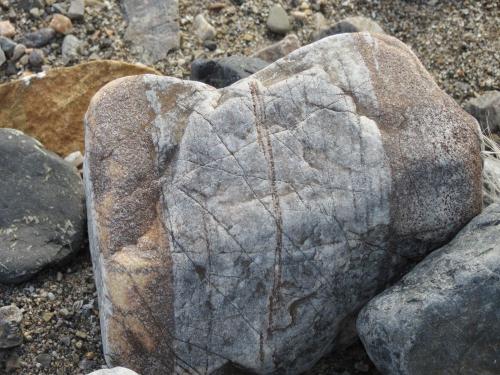 Why is this rock all scratched up?
Why is this rock all scratched up?
- What is that on this rock? (Easy- everyone should get this one.)
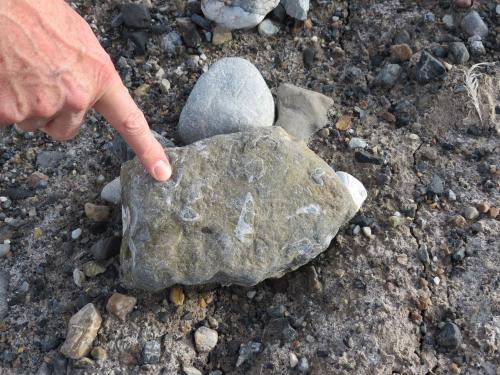 What is that on this rock?
What is that on this rock?
- Geez Louise! What happened to the poor rock in the middle? (Harder- think about what happens to the volume of water when it freezes and melts.)
 What happened to the poor rock in the middle?
What happened to the poor rock in the middle?
- Chocolate swirl? What caused the patterns and structures seen in the mountain behind the glacier? Extra credit if you can name the half circle structure in the middle.
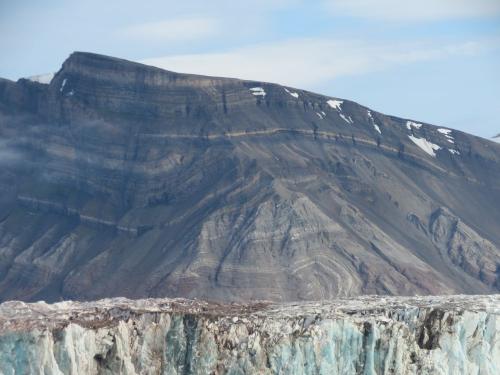 What caused the patterns and structures seen in the mountain behind the glacier?
What caused the patterns and structures seen in the mountain behind the glacier?
- These rocks are angular in shape and poorly sorted. Were they likely transported and deposited by running water?
 Were they likely transported and deposited by running water?
Were they likely transported and deposited by running water?
- This is what the surface was like as we hiked along the side/top of the glacier. There are hollow circular structures in the ice. What may have caused them?
 There are hollow circular structures in the ice. What may have caused them?
There are hollow circular structures in the ice. What may have caused them?
- What makes glaciers and icebergs look blue?
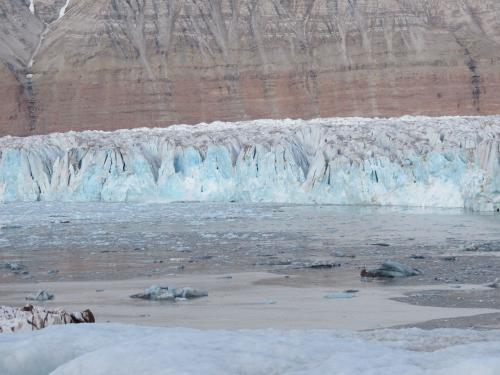 What makes glaciers and icebergs look blue?
What makes glaciers and icebergs look blue?
- We are walking along a raised bed of debris that was "bulldozed" by the glacier. What are these features called?
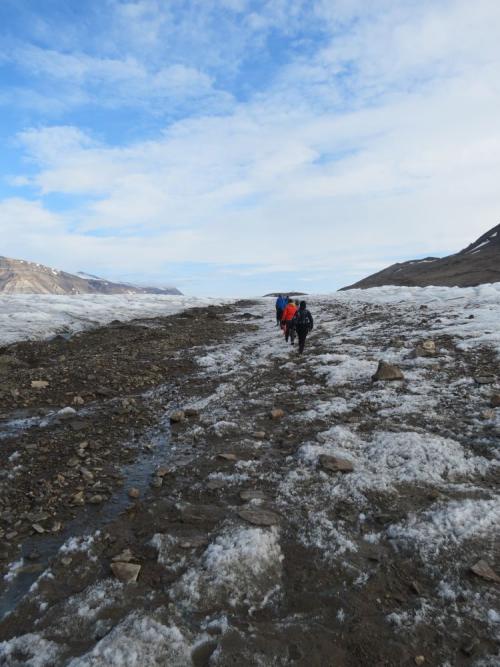 What are these features called?
What are these features called?
- There is a little island forming and a bunch of ice is getting stuck on it. How is this island forming? (Think about what the glacier is doing to the entire area in front of the ice.)
 How is this island forming?
How is this island forming?
- What do you call a little lake formed when partially buried ice blocks melt? (Hint- what do you heat the water for your tea in?)
 What do you call a little lake formed when partially buried ice blocks melt?
What do you call a little lake formed when partially buried ice blocks melt?
Extra credit: Can you tell which way the glacier was moving by looking at this rock?
 Can you tell which way the glacier was moving by looking at tis rock?
Can you tell which way the glacier was moving by looking at tis rock?
Answers (1 point for each correct answer)
- These scratches or gouges are caused by glacial abrasion and are called glacial striations (The glacier scratched the rock as it scraped past it.)
- Fossils, of course! These look like some snails.
- Water penetrated the joints (cracks) in the rock. As the water in the joints alternatively thawed and froze, the rock was weakened. When water freezes it expands. This caused the rock to break apart through a process called frost shattering.
- The layers that you see are strata that represent different periods of time, composition and mode of deposition (like the layers in the Grand Canyon). However, these rocks underwent folding. After deposition they experienced some type of stress that warped their original horizontal position. Give yourself an extra point if you identified the structure in the middle as an anticline. There is a syncline to the left.
- No- running water sorts bed load by size and erodes it to rounded shapes. These rocks do not show signs of water erosion. They were probably forced to the surface by the glacier, perhaps when it merged with another glacier.
- The circular structures were left as air was released from the ice. Kind of like bubbles escaping and being frozen in time.
- Glaciers and icebergs are blue because the crystalline structure of the ice absorbs colors at the red end of the spectrum and the blue wavelengths are left to reflect back to your eyes. The absorption of colors other than blue is optimized with crystal formation under great pressure. As the pressure is released, the crystal structure changes and reflects other wavelengths.
- Moraines! These are the same structures we saw on our hike in Longyearbyen. A moraine is the "bulldozed" debris left by a glacier.
- This is a grounding line fan. The glacier pushes a huge amount of sediment in front of it and deposits it into the fjord where it settles to the bottom and accumulates. At some point it will breach the surface of the water as it is here.
- A kettle lake! Many lakes in Massachusetts, Michigan, New Hampshire and others are kettle lakes.
Extra credit: From the bottom of the photo to the top. Some of the rock has been gauged and cleaved off from bottom to top. The existence of nail-head striations also indicate the direction of movement. You probably needed a course in geology to get this one, but if you did, give yourself an extra point!
Scoring:
8 and above- You rock!
5 to 7- You might be a little "sedimental" about rocks
1 to 4- You don't have much "apatite" for geology!


Comments